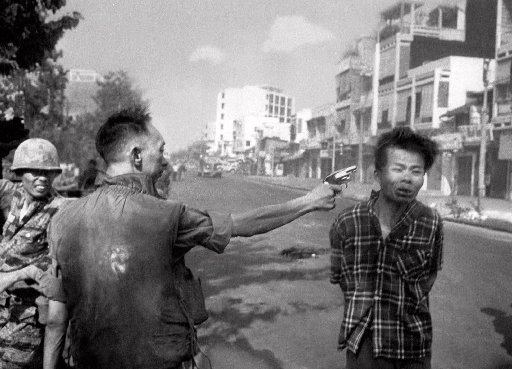Introduction
Expressing emotions and impressions from looking at a photo can be quite a difficult task. This statement could be arguable because the main goal of such work is to have the people go through some sort of visual analysis. However, such analysis could stay private, rather than being described in one’s own words. In that sense, John Updike was brilliant in writing about art and especially about the inner lives of the people depicted in the pictures. Similarly, this paper attempts to analyze a specifically chosen photo, showing the way it could pertain to my life or my ideas. The chosen photo, although being controversial, depicts a Viet Cong officer being shot in the head by the Pulitzer Prize-winning photographer Eddie Adams.

Description
The photo is a black and white image of a Vietnamese General pointing a gun at another hand-cuffed Viet Cong officer. The picture was taken on the first of February, 1968, with seconds away from the execution freezing a moment that assuming defined the fate of all the participants of this photo, including the photographer, Edie Abrams. The picture shows the Viet Cong officer, who was obviously tortured prior to the execution, with a beaten and deformed face. The general, on the other hand, is fully emotionless with a cold expression that points to his experience in repeating the procedure.
First impression
This picture was chosen with an intention to bypass any information regarding the background of the depicted horrible action. The first impression that comes to mind is that no matter how hard the people describe and justify the horrors of the war, it is not something that any ordinary person can get used to. The picture resembles death all over its details. Death in the obviously empty streets, death in the look of the executioner, death in the half-closed eyes of the victim, and death in the whole timeline that preceded or followed that frozen moment. The impressions are contradictory, as are the impressions on the faces of both participants; the first one is a pity to the victim, and to his life that was abruptly ended with a pull of a trigger, the second one is fear, where it covers everything such as the fear of the depicted general, the fear that such image becomes ordinary, and the fear of the country the tragedies of the war can result in the punishment or revenge being executed openly and without a sense of doubt. Another contradiction is witnessed with the stereotype that an action like that being performed at night, in a hidden place, is somewhat contradicting the photo where it was done in the daylight, and on the street.
In His shoes
Being related to the person being shot is hard without knowing the background of the person depicted, therefore after research, it turned out that the person being shot is a war criminal, and assumingly deserved his fate. It could be agreed with Updike, that watching a depiction of something and feeling it, could be expressed in different ways.
Standing there, handcuffed, and desperate it could be predicted that despite the action going around I would feel total silence, where nothing except my heartbeats could be heard.
The seconds between pointing the gun and pulling the trigger seem like an eternity, where life could be revised from the moment of birth till the pre-death seconds. Revising life, one particular moment would be searched for in order to be examined. This moment is the starting point, where it all went wrong. The point is similar to the butterfly effect that triggered the subsequent life events, in a way that it led to this particular point of no return. In those moments, I will wish to turn back the time and have everything worked out differently. The most horrible moment is when standing there; for a particular part of a second, there is a little hope that everything will turn out to be a dream- a nightmare to be precise.
Knowing the moment of your death just seconds before it happens, put limitations on your thoughts, where regrets and forgiveness prevail. At the same time thoughts about your executioner will be shifted, where any emotions prior to pointing the gun, such as hate and anger, will be replaced with indifference. This indifference is coincided with him being transformed into a faceless person, where identities do not matter anymore. The death will be identical, regardless of the person who performs it.
Conclusion
The mere idea of looking at the photo and imagining myself at the place of that Vietcong officer gives an idea of the effect and the impact of this photo. War will never be justified, as well as the means that are taken during its pace. The photo perfectly demonstrates this statement with the emotions that it causes. Additionally, it is indeed a different aspect, watching death and feeling it.